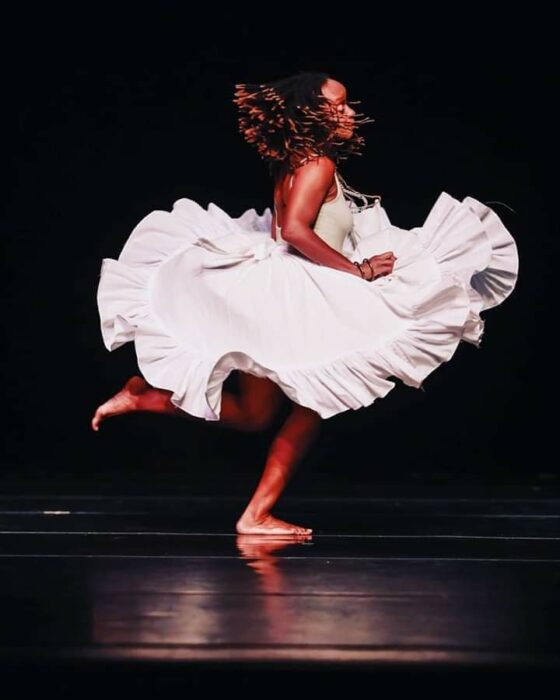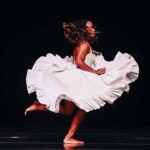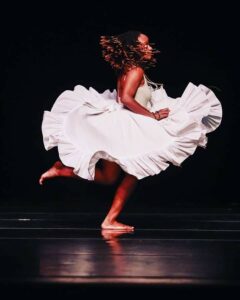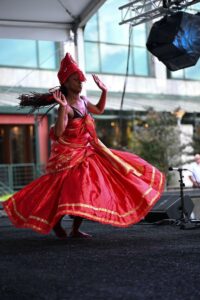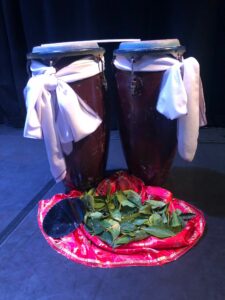Tamara Williams
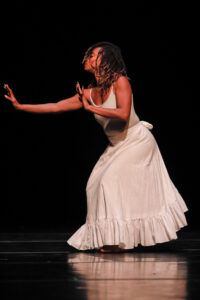
Educator CONTACT INFO
SELECT A PROGRAM
African diaspora dance and music

Program Description
This program brings African diaspora dance forms and rhythms to students through 60 minute and 75 min workshops. Students will learn traditional African-Brazilian dances including Samba roots (raiz), dances of nature, and Indigenous dances of Brazil. Contemporary dances will include Samba Afro and Samba Reggae.
Another option for workshops includes learning African-American rings out traditions.
...Booking / scheduling contact
Program Detail
Tuesdays, Thursdays and Fridays
8 am- 4:30 pm,
Afterschool programming time available, as well
Adequate space for students to move safely and freely
on-site at school
UNC-Charlotte for HS Juniors and Seniors programming
Music $400 per workshop session
Dance $400 per workshop session
Music and dance $600 per workshop session
2 sessions per day:
Music or Dance
$700
2 sessions per day:
Music and dance together
$1100
5 sessions over several days:
Music or Dance
$1500
5 sessions over several days:
Music and dance together
EDUCATION STANDARDS
African diaspora dance can be effectively integrated into the North Carolina Standard Course of Study (NCSCS) by addressing various aspects of dance education, including creation and performance, dance movement skills, responding, and connecting. Here’s how African diaspora dance relates to each of the specific points you mentioned in the 4th-grade curriculum:
CREATION AND PERFORMANCE
4.CP.1 Use choreographic principles, structures, and processes to create dances that communicate ideas, experiences, feelings, and images:
African diaspora dance is often rich in storytelling and symbolism. Students can create dance sequences that reflect the cultural narratives, emotions, and stories from African and diaspora communities.
4.CP.1.1 Organize dance phrases into simple dance sequences that have a beginning, middle, and end, and that vary the use of the dance elements:
Students can organize dance phrases inspired by African diaspora dance forms and explore how different combinations and variations can convey unique narratives and emotional journeys.
4.CP.1.2 Use independent and/or cooperative skills to improvise and create dance:
African diaspora dance often involves group participation and cooperation. Students can engage in improvisational exercises inspired by the communal aspects of African diaspora dance.
4.CP.1.3 Create short dance sequences that communicate ideas, experiences, feelings, images, or stories:
Students can create dance sequences that convey their understanding of the cultural and historical context of African diaspora dance and tell their own stories through movement.
4.CP.1.4 Understand how different strategies for problem-solving in dance lead to different outcomes:
Explore various problem-solving approaches within the context of African diaspora dance. For instance, how does the choice of movement elements affect the storytelling in dance?
4.CP.2 Understand how to use performance values (kinesthetic awareness, concentration, focus, and etiquette) to enhance dance performance:
Emphasize the importance of concentration, focus, and kinesthetic awareness in African diaspora dance. Highlight the cultural and historical significance of these values in the context of performance.
4.CP.2.1 Use control of body, voice, and focus necessary for effective participation in dance:
Students can learn about and practice the specific body control and focus required in African diaspora dance styles.
4.CP.2.2 Use concentration and focus to perform short dance sequences:
Students can explore how deep concentration is essential for performing intricate rhythmic patterns and storytelling in African diaspora dance.
4.CP.2.3 Identify personal goals to improve performance quality in dance:
Encourage students to set personal goals for improvement in their African diaspora dance performances, promoting self-awareness and self-evaluation.
DANCE MOVEMENT SKILLS
4.DM.1 Understand how to use movement skills in dance:
Students can learn and apply specific movement skills found in African diaspora dance styles, such as body isolations, rhythmic patterns, and cultural nuances.
4.DM.1.1 Illustrate safe movement choices through the use of dance technique, including balance, rotation, elevation, and landing in dance movement:
Teach students the principles of safe movement within the context of African diaspora dance, which often includes dynamic footwork and jumps.
4.DM.1.2 Illustrate a variety of ways to use shapes:
Explore the use of body shapes and formations inspired by African diaspora dance, such as circular formations, lines, and more.
4.DM.1.3 Execute locomotor and non-locomotor (axial) movement with clarity and intent:
African diaspora dance often includes both traveling (locomotor) and stationary (axial) movements that students can learn to execute with cultural intent.
4.DM.1.4 Differentiate between duple and triple meter:
Introduce students to the rhythmic patterns, which are often complex and vary between duple and triple meters in African diaspora dance styles.
4.DM.1.5 Execute a variety of group spatial designs and relationships while dancing:
Students can explore and perform dance sequences that incorporate group spatial designs and relationships commonly found in African diaspora dance, such as circles, formations, and patterns.
RESPONDING
4.R.1 Use a variety of thinking skills to analyze and evaluate dance:
Encourage students to analyze and evaluate African diaspora dance performances, identifying movement elements, cultural context, and emotional expression within the dances.
4.R.1.1 Use dance vocabulary to describe elements of movement (body, space, time, energy) while observing dance:
Introduce students to the specific dance vocabulary used in African diaspora dance to describe movement elements and dynamics.
4.R.1.2 Explain how personal perspective influences interpretations of dance:
Explore how different cultural backgrounds and personal perspectives can influence how individuals interpret and appreciate African diaspora dance.
4.R.1.3 Use different aesthetic criteria for evaluating dances:
Encourage students to develop their own aesthetic criteria for evaluating African diaspora dance, considering cultural authenticity, storytelling, and emotional expression.
CONNECTING
4.C.1 Understand cultural, historical, and interdisciplinary connections with dance:
Explore the cultural and historical connections between African diaspora dance and the communities from which they originate. Connect African diaspora dance to broader cultural and historical themes, highlighting its significance in North Carolina.
4.C.1.1 Understand how dance has affected, and is reflected in, the culture, traditions, and history of North Carolina:
Help students understand the influence of African diaspora dance on the culture, traditions, and history of North Carolina and how it is reflected in various aspects of the state’s heritage.
4.C.1.2 Exemplify connections between dance and concepts in other curricular areas:
Explore how African diaspora dance connects with other curricular areas, such as history, geography, and social studies, highlighting its interdisciplinary nature and its role in shaping various aspects of society.
Integrating African diaspora dance into the 4th-grade curriculum in North Carolina can provide students with a culturally rich and physically engaging educational experience, fostering an understanding of the art form and its connections to broader cultural and historical contexts.
______________
African diaspora dance can be integrated into the North Carolina Standard Course of Study (NCSCS) at the 5th-grade level by addressing various aspects of dance education, including creation and performance, dance movement skills, responding, and connecting. Here’s how African diaspora dance can relate to each of the specific points you mentioned in the 5th-grade curriculum:
CREATION AND PERFORMANCE
5.CP.1 Use choreographic principles, structures, and processes to create dances that communicate ideas, experiences, feelings, and images:
African diaspora dance often serves as a powerful medium for conveying cultural narratives, emotions, and stories. Students can create dance pieces that reflect the cultural richness and historical experiences of African and diaspora communities.
5.CP.1.1 Create short dances that use simple choreographic forms and structures (musical, literary, or visual), and that vary the use of dance elements:
Students can use the foundational elements of African diaspora dance, such as rhythms, gestures, and body isolations, to construct short dances that vary in structure and incorporate musical or literary inspirations.
5.CP.1.2 Use collaborative skills to improvise and create dance:
African diaspora dance often involves group participation and collaboration. Students can engage in collaborative improvisation exercises inspired by the communal aspects of African diaspora dance.
5.CP.1.3 Create short dances that communicate abstract ideas:
Challenge students to explore how abstract concepts and themes can be expressed through African diaspora dance movements and narratives.
5.CP.1.4 Generate strategies for problem-solving in dance:
Students can explore various problem-solving strategies within the context of African diaspora dance, such as creating movement patterns that reflect specific historical events or cultural themes.
5.CP.2 Understand how to use performance values (kinesthetic awareness, concentration, focus, and etiquette) to enhance dance performance:
Emphasize the importance of concentration, focus, kinesthetic awareness, and cultural etiquette in African diaspora dance. Highlight the cultural and historical significance of these values in the context of performance.
5.CP.2.1 Execute control of body, voice, and focus necessary for effective participation in individual and group settings in dance:
Students can learn about and practice the specific control of the body, voice, and focus required in African diaspora dance styles.
5.CP.2.2 Use kinesthetic awareness, concentration, and focus to enhance the performance of dance sequences:
Students can explore how deep concentration and kinesthetic awareness are essential for performing intricate rhythmic patterns, storytelling, and expressing emotions in African diaspora dance.
5.CP.2.3 Monitor personal goals to improve performance quality in dance:
Encourage students to set and monitor personal goals for improvement in their African diaspora dance performances, promoting self-awareness and self-evaluation.
DANCE MOVEMENT SKILLS
5.DM.1 Understand how to use movement skills in dance:
Students can learn and apply advanced movement skills found in African diaspora dance styles, including intricate footwork, body isolations, and cultural nuances.
5.DM.1.1 Use muscular strength, flexibility, stamina, and coordination in the development of beginning dance technique:
Introduce students to the physical demands and conditioning required in African diaspora dance, which often includes muscular strength and stamina.
5.DM.1.2 Exemplify how to maintain a sense of body shape while moving and in stillness:
Explore how African diaspora dance often emphasizes precise body shapes, both in motion and during moments of stillness.
5.DM.1.3 Integrate locomotor and non-locomotor (axial) movement and stillness into dance sequences through the use of transitions:
Students can practice seamless transitions between traveling (locomotor) and stationary (axial) movements and stillness, which are common in African diaspora dance.
5.DM.1.4 Illustrate phrasing in a selected piece of music using dance movement:
Teach students how to express musical phrasing through dance movement, incorporating the complex rhythmic patterns found in African diaspora dance.
5.DM.1.5 Use a variety of spatial designs and relationships with clarity and intent while dancing:
Explore and perform dance sequences that incorporate a variety of spatial designs and relationships, reflecting those commonly found in African diaspora dance, such as circular formations and intricate group dynamics.
RESPONDING
5.R.1 Use a variety of thinking skills to analyze and evaluate dance:
Encourage students to analyze and evaluate African diaspora dance performances, identifying movement elements, cultural context, and emotional expression within the dances.
5.R.1.1 Analyze the relationship between dance elements when observing dance:
Challenge students to critically analyze the interplay of elements (body, space, time, energy) in African diaspora dance.
5.R.1.2 Illustrate the roles and responsibilities of the viewer in interpreting dances:
Explore the role of the viewer in interpreting and appreciating African diaspora dance, emphasizing cultural sensitivity and respect.
CONNECTING
5.C.1 Understand cultural, historical, and interdisciplinary connections with dance:
Explore the cultural and historical connections between African diaspora dance and the communities from which they originate. Connect African diaspora dance to broader cultural and historical themes, highlighting its significance in the United States.
5.C.1.1 Understand how dance has affected, and is reflected in, the culture, traditions, and history of the United States:
Help students understand the influence of African diaspora dance on the culture, traditions, and history of the United States and how it is reflected in various aspects of the nation’s heritage.
5.C.1.2 Exemplify connections between dance and concepts in other curricular areas:
Explore how African diaspora dance connects with other curricular areas, such as history, geography, and social studies, highlighting its interdisciplinary nature and its role in shaping various aspects of American society.
__________________
African diaspora dance can be integrated into the 6th-grade curriculum in North Carolina by addressing various aspects of dance education, including creation and performance, dance movement skills, responding, and connecting. Here’s how African diaspora dance can relate to each of the specific points you mentioned:
CREATION AND PERFORMANCE
6.CP.1 Use choreographic principles, structures, and processes to create dances that communicate ideas, experiences, feelings, and images:
African diaspora dance often conveys cultural narratives and emotions. Students can create dance pieces that reflect the cultural richness and historical experiences of African and diaspora communities.
6.CP.1.1 Understand the role of improvisation in choreography:
Students can explore how improvisation plays a significant role in African diaspora dance, where dancers often spontaneously respond to the rhythms and emotions of the music.
6.CP.1.2 Create short dances that have a beginning, middle, and end, and that vary the use of the dance elements:
Encourage students to create dance pieces inspired by African diaspora dance that vary in structure and incorporate cultural and historical elements.
6.CP.1.3 Use abstracted movement to create dance phrases that communicate ideas, experiences, feelings, or images:
Challenge students to use abstract movement in their choreography to convey complex cultural ideas and emotions.
6.CP.1.4 Use collaborative and cooperative skills to contribute constructively to the creation of dance:
African diaspora dance often involves group participation and collaboration. Students can engage in group choreographic projects inspired by the communal aspects of African diaspora dance.
6.CP.2 Understand how to use performance values (kinesthetic awareness, concentration, focus, and etiquette) to enhance dance performance:
Emphasize the importance of concentration, focus, kinesthetic awareness, and cultural etiquette in African diaspora dance. Highlight the cultural and historical significance of these values in the context of performance.
6.CP.2.1 Use safe and respectful behaviors as a dance class participant:
Teach students about the importance of respect and safety in the dance class, reflecting the values found in African diaspora dance communities.
6.CP.2.2 Use concentration and focus while dancing:
Explore how deep concentration and focus are essential for performing intricate rhythms and storytelling in African diaspora dance.
6.CP.2.3 Understand how self-assessment, teacher feedback, and peer feedback can be used to refine dance performance:
Encourage students to engage in self-assessment, peer feedback, and teacher feedback to refine their African diaspora dance performances, fostering self-awareness and continuous improvement.
DANCE MOVEMENT SKILLS
6.DM.1 Understand how to use movement skills in dance:
Students can learn and apply advanced movement skills found in African diaspora dance styles, such as intricate footwork, body isolations, and cultural nuances.
6.DM.1.1 Understand the purpose of beginning dance technique in terms of developing muscular strength, alignment, flexibility, stamina, and coordination:
Introduce students to the physical demands and conditioning required in African diaspora dance, emphasizing the development of muscular strength and coordination.
6.DM.1.2 Compare qualities within the elements of time, space, weight, and flow in dance:
Explore how African diaspora dance employs unique qualities within these dance elements to convey cultural and emotional nuances.
6.DM.1.3 Execute technical skills from a variety of dance forms:
Students can practice and incorporate technical skills from various African diaspora dance forms into their own dance sequences.
6.DM.1.4 Analyze the components of time in dance:
Explore the intricate rhythms and time signatures often found in African diaspora dance, allowing students to analyze and incorporate these elements into their own dance pieces.
RESPONDING
6.R.1 Use a variety of thinking skills to analyze and evaluate dance:
Encourage students to critically analyze and evaluate African diaspora dance performances, identifying movement elements, cultural context, and emotional expression within the dances.
6.R.1.1 Analyze the relationship between dance elements when observing dance:
Challenge students to analyze the interplay of elements (body, space, time, energy) in African diaspora dance and how they contribute to the overall message of the dance.
6.R.1.2 Interpret the meanings of dances created by peers and others:
Promote discussions and interpretations of dances created by peers and professional dancers, exploring the cultural and emotional meanings conveyed through movement.
CONNECTING
6.C.1 Understand cultural, historical, and interdisciplinary connections with dance:
Explore the cultural and historical connections between African diaspora dance and the communities from which they originate. Connect African diaspora dance to broader cultural and historical themes, highlighting its global significance.
6.C.1.1 Understand dance in relationship to the geography, history, and culture of world civilizations and societies from the beginning of human society to the emergence of the First Global Age (1450):
Examine the influence of African diaspora dance on world civilizations and societies throughout history, particularly its role in the African diaspora and its impact on various cultures.
6.C.1.2 Exemplify connections between dance and concepts in other curricular areas:
Explore how African diaspora dance connects with other curricular areas, such as history, geography, and social studies, highlighting its interdisciplinary nature and its role in shaping
_____________
African diaspora dance can be effectively integrated into the 7th-grade curriculum in North Carolina by addressing various aspects of dance education, including creation and performance, dance movement skills, responding, and connecting. Here’s how African diaspora dance can relate to each of the specific points you mentioned in the 7th-grade curriculum:
CREATION AND PERFORMANCE
7.CP.1 Use choreographic principles, structures, and processes to create dances that communicate ideas, experiences, feelings, and images:
African diaspora dance often serves as a powerful medium for conveying cultural narratives, emotions, and stories. Students can create dance pieces that reflect the cultural narratives and historical experiences of African and diaspora communities.
7.CP.1.1 Explain a variety of approaches to choreography:
Explore the various choreographic approaches used in African diaspora dance, such as traditional African dance forms, Afro-Caribbean styles, and contemporary adaptations. Discuss how each approach conveys ideas, experiences, and emotions.
7.CP.1.2 Create dances that use simple choreographic forms and structures (musical, literary, or visual), fulfill choreographic intent, and meet aesthetic criteria:
Encourage students to create choreography inspired by African diaspora dance that adheres to the cultural and historical context while meeting aesthetic criteria.
7.CP.1.3 Select movement phrases to create dance sequences that communicate ideas, experiences, feelings, images, or stories:
Challenge students to select and arrange movement phrases inspired by African diaspora dance forms to convey specific ideas, experiences, and stories.
7.CP.1.4 Generate solutions to technical or structural movement problems in the creative process:
Explore how African diaspora dance often involves complex technical and structural challenges. Encourage students to devise creative solutions to these challenges in their own choreography.
7.CP.2 Understand how to use performance values (kinesthetic awareness, concentration, focus, and etiquette) to enhance dance performance:
Emphasize the importance of concentration, focus, kinesthetic awareness, and cultural etiquette in African diaspora dance. Highlight the cultural and historical significance of these values in the context of performance.
7.CP.2.1 Use safe and respectful behaviors as a dance class participant:
Teach students about the importance of respect, safety, and cultural sensitivity in the dance class, reflecting the values found in African diaspora dance communities.
7.CP.2.2 Use clarity, concentration, and focus while dancing:
Explore how deep concentration and clarity are essential for performing intricate rhythms and storytelling in African diaspora dance.
7.CP.2.3 Use self-assessment, teacher feedback, and peer feedback to refine dance performance quality:
Encourage students to engage in self-assessment, peer feedback, and teacher feedback to refine their African diaspora dance performances, fostering self-awareness and continuous improvement.
DANCE MOVEMENT SKILLS
7.DM.1 Understand how to use movement skills in dance:
Students can learn and apply advanced movement skills found in African diaspora dance styles, including intricate footwork, body isolations, and cultural nuances.
7.DM.1.1 Understand how dance technique uses anatomical concepts of alignment, strength, and range of motion:
Introduce students to the anatomical concepts underpinning African diaspora dance techniques, emphasizing alignment, strength, and range of motion.
7.DM.1.2 Apply the effort qualities of time, space, weight, and flow in dance:
Explore how African diaspora dance employs unique qualities within these elements to convey cultural and emotional nuances.
7.DM.1.3 Apply technical skills from a variety of dance traditions:
Students can practice and incorporate technical skills from various African diaspora dance forms into their own dance sequences.
7.DM.1.4 Use breath to facilitate movement in dancing:
Explore the use of breath control and its significance in African diaspora dance, particularly in the context of sustained movements and rhythmic patterns.
RESPONDING
7.R.1 Use a variety of thinking skills to analyze and evaluate dance:
Encourage students to critically analyze and evaluate African diaspora dance performances, identifying movement elements, cultural context, and emotional expression within the dances.
7.R.1.1 Use dance vocabulary to describe how elements of movement are used to communicate ideas in dance:
Teach students to employ dance vocabulary to describe how movement elements in African diaspora dance are used to convey ideas, stories, and cultural expressions.
7.R.1.2 Understand how personal experiences and perspectives influence interpretations of dance:
Explore how different cultural backgrounds and personal experiences can influence how individuals interpret and appreciate African diaspora dance.
CONNECTING
7.C.1 Understand cultural, historical, and interdisciplinary connections with dance:
Explore the cultural and historical connections between African diaspora dance and the communities from which they originate. Connect African diaspora dance to broader cultural and historical themes, highlighting its global significance and its role in modern societies.
7.C.1.1 Understand dance in relationship to the geography, history, and culture of modern societies from the emergence of the First Global Age (1450) to the present:
Examine the influence of African diaspora dance on modern societies, particularly in the context of the African diaspora and its impact on various cultures and contemporary dance forms.
7.C.1.2 Exemplify connections between dance and concepts in other curricular areas:
Explore how African diaspora dance connects with other curricular areas, such as history, geography, and social studies, highlighting its interdisciplinary nature and its role in shaping contemporary society.
7.C.1.3 Explain how to promote health, physical safety:
Discuss how African diaspora dance promotes physical well-being and discuss the importance of safe and healthy dance practices within the context of this art form.
_______________
African diaspora dance can be integrated into the 8th-grade curriculum in North Carolina by addressing various aspects of dance education, including creation and performance, dance movement skills, responding, and connecting. Here’s how African diaspora dance can relate to each of the specific points you mentioned in the 8th-grade curriculum:
CREATION AND PERFORMANCE
8.CP.1 Use choreographic principles, structures, and processes to create dances that communicate ideas, experiences, feelings, and images:
African diaspora dance often conveys cultural narratives, emotions, and stories. Students can create dance pieces that reflect the cultural narratives and historical experiences of African and diaspora communities.
8.CP.1.1 Use a variety of approaches, such as musical, literary, or visual forms, to choreograph dances:
Encourage students to explore different creative approaches, including those inspired by the music, literature, and visual arts related to African diaspora cultures.
8.CP.1.2 Create dances that fulfill aesthetic criteria including: beginning, development of an idea, resolution, and end; use of variety in the elements of dance; artistic form; and communication of the intent of the choreographer:
Challenge students to create choreography inspired by African diaspora dance that adheres to these aesthetic criteria while conveying cultural and historical narratives.
8.CP.1.3 Organize dance sequences into simple dances that communicate ideas, experiences, feelings, images, or stories:
Students can organize dance sequences inspired by African diaspora dance forms to convey specific ideas, experiences, and stories.
8.CP.1.4 Use reflection and discussion to revise choreography:
Encourage students to engage in reflective practices and discussions to refine their choreography, drawing from the collaborative and constructive aspects often found in African diaspora dance communities.
8.CP.2 Understand how to use performance values (kinesthetic awareness, concentration, focus, and etiquette) to enhance dance performance:
Emphasize the importance of concentration, focus, kinesthetic awareness, and cultural etiquette in African diaspora dance. Highlight the cultural and historical significance of these values in the context of performance.
8.CP.2.1 Use safe and respectful behaviors as a dance class participant:
Teach students about the importance of respect, safety, and cultural sensitivity in the dance class, reflecting the values found in African diaspora dance communities.
8.CP.2.2 Integrate the use of clarity, concentration, and focus while dancing:
Explore how deep concentration and clarity are essential for performing intricate rhythms and storytelling in African diaspora dance.
8.CP.2.3 Integrate self-assessment, teacher feedback, and peer feedback in the process of refining dance performance:
Encourage students to engage in self-assessment, peer feedback, and teacher feedback to refine their African diaspora dance performances, fostering self-awareness and continuous improvement.
DANCE MOVEMENT SKILLS
8.DM.1 Understand how to use movement skills in dance:
Students can learn and apply advanced movement skills found in African diaspora dance styles, including intricate footwork, body isolations, and cultural nuances.
8.DM.1.1 Apply anatomical concepts to movements that are vertical, off-vertical, and on one leg with balance, agility, endurance, and ease of movement:
Explore the anatomical concepts and physical demands involved in executing challenging movements in African diaspora dance styles.
8.DM.1.2 Apply combinations of time, space, weight, and flow in dance:
Encourage students to incorporate these elements into their dance sequences, drawing from the complexity often found in African diaspora dance forms.
8.DM.1.3 Execute technical skills in dance:
Students can practice and incorporate technical skills from various African diaspora dance forms into their own dance sequences.
8.DM.1.4 Integrate breath support to facilitate and clarify movement:
Explore the use of breath control and its significance in African diaspora dance, particularly in the context of sustained movements and rhythmic patterns.
RESPONDING
8.R.1 Use a variety of thinking skills to analyze and evaluate dance:
Encourage students to critically analyze and evaluate African diaspora dance performances, identifying movement elements, cultural context, and emotional expression within the dances.
8.R.1.1 Use accurate terminology to describe the major movement ideas, elements, and choreographic structures of dance:
Teach students to employ precise dance terminology to describe the unique movement elements and structures found in African diaspora dance.
8.R.1.2 Use multiple perspectives and criteria in evaluating dances:
Promote discussions and diverse perspectives in evaluating African diaspora dance performances, considering cultural, historical, and artistic criteria.
CONNECTING
8.C.1 Understand cultural, historical, and interdisciplinary connections with dance:
Explore the cultural and historical connections between African diaspora dance and the communities from which they originate. Connect African diaspora dance to broader cultural and historical themes, highlighting its global significance and its role in modern societies.
8.C.1.1 Understand the role of dance in North Carolina and the United States in relation to history and geography:
Examine the influence of African diaspora dance on the history, culture, and geography of North Carolina, the United States, and the broader African diaspora.
8.C.1.2 Exemplify connections between dance and concepts in other curricular areas:
Explore how African diaspora dance connects with other curricular areas, such as history, geography, and social studies, highlighting its interdisciplinary nature and its role in shaping contemporary society.
8.C.1.3 Design personal strategies to improve health and well-being through dance:
Discuss how African diaspora dance promotes physical and mental well-being and encourage students to design personal strategies for maintaining health through dance.
8.C.1.4 Explain the implications of career pathways and economic considerations when selecting careers in dance:
African diaspora dance is rich with cultural, historical, and musical significance, making it a valuable resource for teaching and connecting with North Carolina’s Essential Standards in history, music, and dance. Here’s how African diaspora dance applies to these standards:
History:
Cultural and Historical Context: African diaspora dance reflects the history of African peoples who were forcibly taken from their homelands and dispersed throughout the Americas. This dance form serves as a living testimony to the resilience, cultural preservation, and resistance of African descendants during slavery and beyond. By studying African diaspora dance, students can gain a deeper understanding of this historical context.
Cultural Exchange and Syncretism: African diaspora dance often embodies the fusion of African, indigenous, and European cultures, resulting in a rich tapestry of movement, music, and storytelling. This cultural exchange and syncretism are essential for understanding the complex history of African descendants in the Americas.
Abolition and Civil Rights Movements: African diaspora dance played a significant role in the abolition of slavery and the civil rights movements. Dances like the Ring Shout and Tap dance served as forms of resistance and expressions of cultural identity during challenging times. Studying these dance forms can help students explore the history of social justice movements in the United States.
Music:
Rhythmic Complexity: African diaspora dance is closely tied to complex rhythms, which are an integral part of the music. Students can learn about intricate polyrhythms, syncopation, and the use of percussion instruments such as drums and claves in these dance traditions.
Musical Instruments: African diaspora dance often involves the use of traditional instruments like djembes, congas, maracas, and other percussion instruments. Students can explore the sounds, roles, and cultural significance of these instruments in the context of dance and music.
Musical Styles: Various styles of African diaspora dance are closely associated with specific musical genres, such as Samba with Brazilian music, Salsa with Afro-Cuban music, and Afrobeat with West African music. Exploring these connections helps students appreciate the musical diversity of the African diaspora.
Dance:
Dance Techniques: African diaspora dance encompasses a wide range of dance techniques, from the polyrhythmic footwork of Tap dance to the hip movements of Samba. Students can learn these techniques, developing their physical skills and understanding of diverse dance forms.
Cultural and Historical Context: Teaching African diaspora dance allows students to connect dance to its cultural and historical context. They can explore the origins, rituals, and social meanings of these dances within specific communities.
Choreography and Performance: Students can engage in choreographic activities inspired by African diaspora dance, creating their own dances or performing traditional choreography. This provides a platform for them to express themselves, tell stories, and understand the role of dance as a means of communication.
Collaboration and Community: African diaspora dance often emphasizes community participation and collaboration. Students can experience the sense of unity and cultural pride that comes with participating in these dance forms.
Body Awareness and Expressiveness: Learning African diaspora dance promotes body awareness, control, and expressiveness. Students can explore the relationships between movement, rhythm, and storytelling in dance.
In summary, African diaspora dance serves as a dynamic and multifaceted educational tool that can help students engage with North Carolina’s Essential Standards in history, music, and dance. By exploring the cultural, historical, and artistic dimensions of these dance forms, students can gain a more holistic understanding of the African diaspora’s impact on the state and the United States as a whole.
References
Kim Jones, Associate Professor of Dance at UNC Charlotte
K.jones@charlotte.edu
Maxine Montilus, Choreographer and dance performer
Maxine.montilus@gmail.com
Cancellation Policy
Within 3 weeks, 50% of program fee
Within 3 days, 75% of program fee

